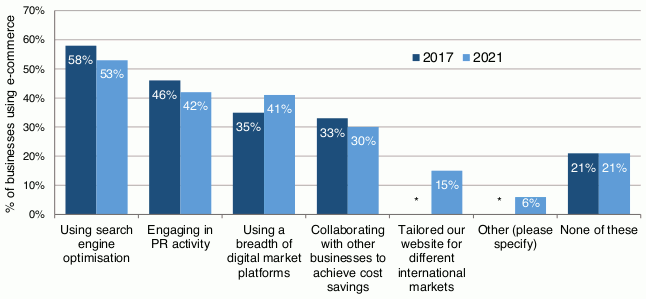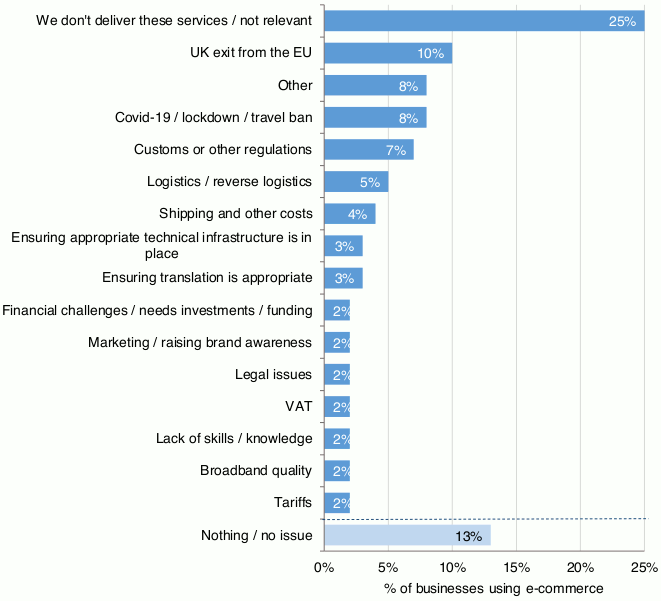Digital Economy Business Survey 2021: findings
Summary of findings from the Digital Economy Business Survey (DEBS) 2021. This publication includes the high level DEBS report, accompanying data tables and the Digital Economy Maturity Index 2021.
This document is part of a collection
Internationalisation and E-Commerce
The internet and digital technologies enable businesses of any size in any location to access global markets. This creates opportunity for businesses to trade not just with local markets but with the world.
Effective use of digital technologies, including E-Commerce platforms, tailoring company websites to international markets and using digital marketing and social media, can enable businesses across all sectors to easily reach these markets and increase their export potential.
The following section looks at the extent to which businesses in Scotland engage in E-Commerce, and how it is used to enhance their sales outside the UK.
| Expected Change | In Scotland | Outside of Scotland, but in the rest of the UK | Outside of the UK, within the EU | Outside of the UK, outside of the EU |
|---|---|---|---|---|
| Increase | 52% | 47% | 26% | 31% |
| Stay the same | 34% | 34% | 27% | 25% |
| Decrease | 8% | 8% | 19% | 11% |
| Not applicable | 2% | 8% | 24% | 28% |
| Don’t know | 4% | 3% | 5% | 5% |
| Base | 3,286 | 1,946 | 1,255 | 1,172 |
Base: Businesses currently selling in each market (min = 1,172)
Destination of sales made by Scottish businesses (see Figure 6)
- Of all businesses surveyed in 2021, 97 per cent sold their goods or services in Scotland, and half (50 per cent) made sales to the rest of the UK. 27 per cent sold their goods or services to markets internationally (outside of the UK). 24 per cent of businesses sold within the EU and 20 per cent outside of the EU.
- 23 per cent of businesses plan to sell goods or services to new or different markets in the next 12 months. 73 per cent had no plans to do so.
- Of those businesses that reported to selling their goods or services in each market, the most common plan was to increase sales in their current markets in the next 12 months (see figure 6).
| Proportion of sales | Current e-commerce sales (% of all businesses) |
Current e-commerce sales made to other businesses (B2B) (% of businesses using E-Commerce) |
|---|---|---|
| All - 100% | 4 | 13 |
| 80-99% | 5 | 5 |
| 60-79% | 3 | 5 |
| 40-59% | 4 | 7 |
| 20-39% | 5 | 9 |
| Less than 20% | 13 | 23 |
| None | 61 | 34 |
| Don't know | 4 | 3 |
| Any Sales | 35 | 63 |
| Base | 3,346 | 1,244 |
Business use of E-Commerce (see Figure 7)
- Overall, 35 per cent of businesses surveyed in 2021 made sales via e-commerce in the last 12 months, an increase from 30 per cent in 2017. Of those businesses, 63 per cent had made e-commerce sales to other businesses (B2B).
- 13 per cent of businesses made up to one fifth of their sales via e-commerce, while four per cent of businesses made all of their sales via E-Commerce (an increase from one per cent in 2017).
- 13 per cent of businesses using E-Commerce make all of their online sales to other businesses. 23 per cent of businesses made up to one fifth of their E-Commerce to other businesses.
- When asked how sales via e-commerce had changed compared pre-pandemic[5] (i.e. prior to March 2020), 30 per cent of businesses using E-Commerce noted that online sales had increased. 30 per cent of businesses were making a similar proportion of their sales via e-commerce compared to pre-pandemic, and 24 per cent saw a decline in sales.
- Six per cent of businesses starting selling online during the pandemic (i.e. post March 2020) while four per cent stopped selling online.

Base: All businesses using e-commerce (2017 = 1,006, 2021 = 1,244)
Multiple responses allowed
E-commerce tools and methods (see Figure 8)
- The most common action being taken by businesses using e-commerce to maximise their digital presence and support e-commerce activity was search engine optimisation (53 per cent). 42 per cent of businesses using e-commerce engaged in PR activity, and 41 per cent used digital marketing platforms.
- 21 per cent of businesses using e-commerce had not taken any steps to maximise their digital presence, unchanged from 2017.
- 18 per cent of businesses used digital marketplaces or platforms (e.g. Amazon, eBay) in 2021.

Base: All businesses using e-commerce (min = 1,244)
Multiple responses allowed
Barriers to E-Commerce and internationalisation
- The most common reason for not engaging in e-commerce was that it was not relevant to the business (83 per cent), broadly in line with 2017 (81 per cent). Three per cent reported that the Covid-19 pandemic was a barrier to their business selling online.
- Thinking about the future, 28 per cent of businesses not currently using E-Commerce expected to make sales via E-Commerce over the next 2-3 years.
- A variety of challenges were perceived by businesses using e-commerce that would affect their ability to deliver international e-commerce services, including: UK exit from EU (10 per cent); Covid-19 pandemic (8 per cent); customs or other regulations (7 per cent); logistics/ reverse logistics (5 per cent); and shipping and other costs (4 per cent) (see Figure 9).
Contact
Email: Sean.Murchie@gov.scot
There is a problem
Thanks for your feedback